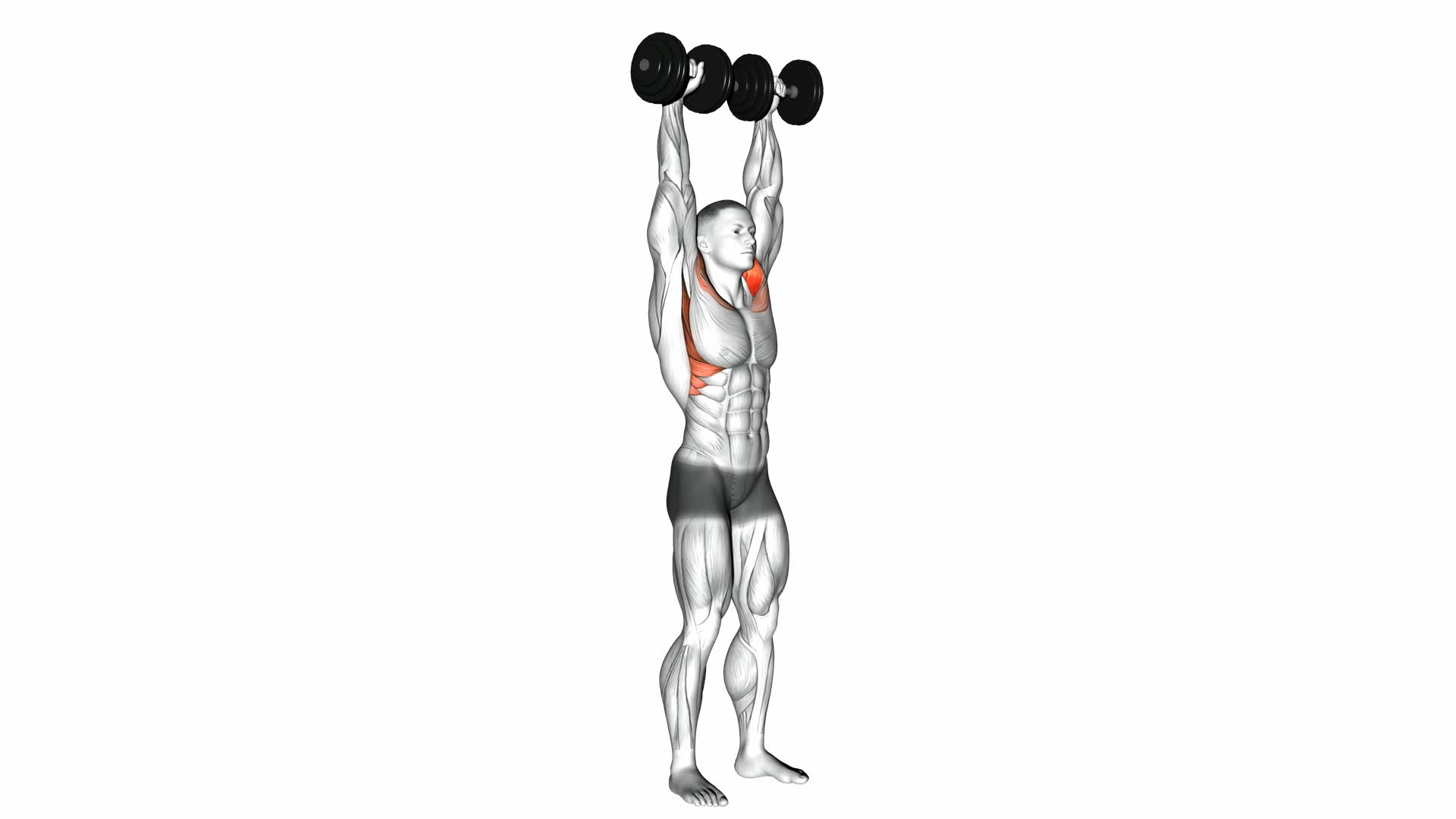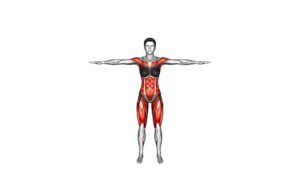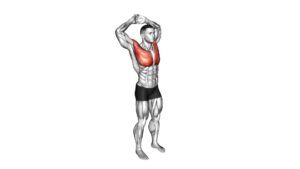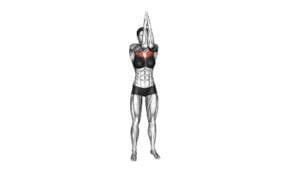Dumbbell Standing Front Raise Above Head – Video Exercise Guide & Tips

Are you looking to strengthen your shoulders and arms? The dumbbell standing front raise above head is a perfect exercise for you.
Watch This Exercise Video
In this video exercise guide, we will show you the proper technique and provide helpful tips to maximize your results.
Avoid common mistakes and explore variations for all fitness levels.
Get ready to elevate your workout routine and achieve your fitness goals. Let's dive in!
Key Takeaways
- Targets and strengthens deltoid muscles
- Increases size and definition of shoulder muscles
- Improves overall upper body strength
- Enhances stability and balance
Benefits of the Dumbbell Standing Front Raise
The dumbbell standing front raise offers several benefits for your upper body strength and shoulder muscles. This exercise is a great way to target and strengthen your deltoids, which are the muscles located at the top of your shoulders. By performing the dumbbell standing front raise, you can increase the size and definition of your shoulder muscles, giving you a more sculpted and toned appearance.
One of the main advantages of this exercise is that it helps to improve your overall upper body strength. As you lift the dumbbells in front of your body, you're engaging several muscle groups, including your deltoids, biceps, and trapezius. This not only helps to strengthen these muscles but also improves your overall stability and balance.
Additionally, the dumbbell standing front raise is a functional exercise that mimics everyday movements. By lifting the dumbbells in front of your body, you're simulating movements such as lifting heavy objects or reaching for something on a high shelf. This can improve your ability to perform these tasks in your daily life, making it easier and safer.
Proper Technique for the Exercise
To perform the dumbbell standing front raise with proper technique, focus on maintaining control and engaging your core throughout the exercise. This will help to maximize muscle activation during the movement and prevent any unnecessary strain on your body. Here are some key points to keep in mind:
- Stand with your feet shoulder-width apart and hold a dumbbell in each hand, palms facing your body.
- Begin the exercise by slowly raising the dumbbells in front of you, keeping your arms straight and your elbows slightly bent.
- As you lift the dumbbells, exhale and focus on using your shoulder muscles to raise the weights. This will ensure proper muscle activation during the front raise.
- Avoid using momentum or swinging your body to lift the dumbbells. Instead, concentrate on a controlled and deliberate movement.
- When the dumbbells reach shoulder level, pause for a moment before slowly lowering them back down to the starting position.
- Throughout the exercise, remember to maintain proper posture and engage your core to stabilize your body.
Common Mistakes to Avoid
Avoiding these common mistakes will help you maximize the effectiveness of the dumbbell standing front raise exercise. To ensure proper form, it's important to be aware of these mistakes and make the necessary adjustments.
One common mistake is using too much weight. It's important to start with a weight that you can comfortably lift and control throughout the exercise. Using too heavy of a weight can lead to improper form and increase the risk of injury.
Another common mistake is swinging the dumbbells. This often happens when people try to lift too much weight or use momentum to complete the movement. Instead, focus on using controlled movements and lifting the dumbbells straight up in front of you.
It is also important to avoid arching your back during the exercise. This can put unnecessary strain on your lower back and decrease the effectiveness of the exercise. Keep your core engaged and maintain a neutral spine throughout the movement.
Lastly, avoid locking out your elbows at the top of the movement. This can lead to excessive stress on the joints and increase the risk of injury. Instead, keep a slight bend in your elbows throughout the exercise.
Variations and Modifications for All Fitness Levels
Try different variations and modifications of the dumbbell standing front raise exercise to cater to your fitness level. Here are some options to consider:
- Grip Variation: Experiment with different grips, such as a wide grip or a narrow grip, to target different muscles in your shoulders and arms.
- Weight Variation: Adjust the weight of the dumbbells to increase or decrease the intensity of the exercise. Start with lighter weights if you're a beginner and gradually increase as you build strength.
- Alternating Arm Raise: Instead of raising both arms simultaneously, try raising one arm at a time. This variation helps improve stability and balance while targeting each arm individually.
Modifications can also be made to accommodate those with specific needs or limitations:
- Seated Front Raise: If standing is challenging for you, try performing the front raise exercise while seated on a bench or chair. This modification allows you to focus solely on the movement without worrying about balance.
- Resistance Band Front Raise: For individuals who don't have access to dumbbells or prefer a different type of resistance, using a resistance band can provide a similar workout. Simply step on the band and hold the handles, then raise your arms forward.
- Bent Elbow Front Raise: If you have any shoulder issues, bending your elbows slightly during the exercise can help alleviate stress on the joint while still engaging the muscles effectively.
Remember to consult with a fitness professional or trainer to determine the most suitable variations and modifications for your specific fitness level and goals.
Tips for Getting the Most Out of Your Workout
To maximize your workout results, incorporate these tips into your routine.
Maximizing results and avoiding plateaus are essential for achieving your fitness goals.
First, vary your exercises to keep your body challenged and prevent adaptation. By constantly changing your routine, you'll engage different muscle groups and stimulate growth.
Additionally, make sure to increase the intensity of your workouts gradually. Pushing yourself too hard too soon can lead to injury or burnout. Instead, gradually increase weights, reps, or duration to challenge your body without overwhelming it.
Another tip is to focus on proper form. Performing exercises correctly ensures that you're targeting the intended muscles and minimizing the risk of injury. Pay attention to your posture, alignment, and breathing.
Lastly, don't forget to rest and recover. Rest days are just as important as workout days. Give your body time to repair and rebuild, allowing for optimal muscle growth and preventing overtraining.
Frequently Asked Questions
How Many Sets and Repetitions Should I Do for the Dumbbell Standing Front Raise?
To determine the number of sets and repetitions for the dumbbell standing front raise, consider your fitness goals and current abilities.
Start with 2-3 sets of 8-12 repetitions, focusing on proper form and controlled movements.
As you progress, you can increase the weight and intensity.
The dumbbell standing front raise variations offer benefits such as strengthening your shoulder muscles, improving posture, and enhancing overall upper body strength.
Can I Use a Barbell Instead of Dumbbells for the Standing Front Raise?
Yes, you can definitely use a barbell instead of dumbbells for the standing front raise. The barbell allows you to increase the weight and challenge your muscles even more.
However, it might be more beneficial to do the seated front raise with a barbell as it provides more stability and isolates the shoulder muscles.
The standing front raise engages more of your core and stabilizer muscles.
Ultimately, it depends on your fitness goals and personal preference.
Is the Dumbbell Standing Front Raise a Good Exercise for Building Shoulder Strength?
Yes, the dumbbell standing front raise is a great exercise for building shoulder strength. It targets the front deltoids and also works the side deltoids and upper traps.
If you're looking for alternatives, you can try the barbell standing front raise or the cable front raise.
To incorporate the dumbbell standing front raise into a full upper body workout routine, you can pair it with exercises like shoulder presses, lateral raises, and bent-over rows for a well-rounded workout.
Can I Perform the Dumbbell Standing Front Raise Seated Instead of Standing?
Yes, you can perform the dumbbell standing front raise seated instead of standing.
However, it's important to note that the standing position offers unique benefits. By standing, you engage your core muscles for stability and balance, which enhances overall strength and coordination. Additionally, the standing position allows for a greater range of motion, targeting the shoulder muscles more effectively.
Nevertheless, if you have any physical limitations or prefer a seated position, modifications can be made to accommodate your needs.
Should I Perform the Exercise With a Slow or Fast Tempo for Maximum Results?
To maximize your results, it's important to consider the tempo of your dumbbell standing front raise exercise. Whether you choose a slow or fast tempo depends on your goals.
A slow tempo emphasizes muscle control and endurance, while a fast tempo focuses on power and explosiveness.
Experiment with both tempos to find what works best for you. Remember, proper form and technique are crucial regardless of the tempo you choose.
Conclusion
The dumbbell standing front raise is an effective exercise for targeting the shoulders and upper body. By using proper technique and avoiding common mistakes, you can maximize the benefits of this exercise.
Additionally, variations and modifications make it suitable for all fitness levels. Remember to follow the tips provided to get the most out of your workout.
Incorporate this exercise into your routine for improved shoulder strength and overall fitness.

Author
Years ago, the spark of my life’s passion ignited in my mind the moment I stepped into the local gym for the first time. The inaugural bead of perspiration, the initial endeavor, the very first surge of endorphins, and a sense of pride that washed over me post-workout marked the beginning of my deep-seated interest in strength sports, fitness, and sports nutrition. This very curiosity blossomed rapidly into a profound fascination, propelling me to earn a Master’s degree in Physical Education from the Academy of Physical Education in Krakow, followed by a Sports Manager diploma from the Jagiellonian University. My journey of growth led me to gain more specialized qualifications, such as being a certified personal trainer with a focus on sports dietetics, a lifeguard, and an instructor for wellness and corrective gymnastics. Theoretical knowledge paired seamlessly with practical experience, reinforcing my belief that the transformation of individuals under my guidance was also a reflection of my personal growth. This belief holds true even today. Each day, I strive to push the boundaries and explore new realms. These realms gently elevate me to greater heights. The unique combination of passion for my field and the continuous quest for growth fuels my drive to break new ground.







